Microwave Non-Destructive Testing for Delamination Detection in Layered Composite Pipelines
Abstract
1. Introduction
1.1. Near-Field Imaging Technique
1.2. Delamination Crack Characteristics
1.3. Goals
2. Materials and Methods
2.1. Open-Ended Waveguide Defectoscopy Measurement System
2.2. Pipeline Composite Samples
3. Results and Discussion
3.1. Reflection Measurements
3.2. Transmission Measurements
4. Conclusions
Author Contributions
Funding
Institutional Review Board Statement
Informed Consent Statement
Data Availability Statement
Conflicts of Interest
Abbreviations
| CP | Conducting plate |
| EM | Electromagnetic |
| EME | Electromagnetic environment |
| MUT | Medium under test |
| NDT | Non-destructive testing |
| OEWP | Open-ended waveguide probe |
| VNA | Vector network analyzer |
References
- Zoughi, R. Microwave Non-Destructive Testing and Evaluation; Springer: Dordrecht, The Netherlands, 2000. [Google Scholar]
- Carrigan, T.D.; Forrest, B.E.; Andem, H.N.; Gui, K.; Johnson, L.; Hibbert, J.E.; Lennox, B.; Sloan, R. Nondestructive Testing of Nonmetallic Pipelines Using Microwave Reflectometry on an In-Line Inspection Robot. IEEE Trans. Instrum. Meas. 2018, 68, 586–594. [Google Scholar] [CrossRef]
- Li, Z.; Soutis, C.; Haigh, A.; Sloan, R.; Gibson, A.; Karimian, N. Microwave imaging for delamination detection in T-joints of wind turbine composite blades. In Proceedings of the 2016 46th European Microwave Conference (EuMC), London, UK, 4–6 October 2016; pp. 1235–1238. [Google Scholar] [CrossRef]
- Ivashov, S.; Zhuravlev, A.; Razevig, V.; Chizh, M.; Bechtel, T.; Capineri, L.; Thomas, B. Frequency Influence in Microwave Subsurface Holography for Composite Materials Testing. In Proceedings of the 2018 17th International Conference on Ground Penetrating Radar (GPR), Rapperswil, Switzerland, 18–21 June 2018; pp. 1–4. [Google Scholar] [CrossRef]
- Pastorino, M. Microwave Imaging Methods and Applications; Artech House: Boston, MA, USA, 2018. [Google Scholar]
- Merlo, E.M.; Bulletti, A.; Giannelli, P.; Calzolai, M.; Capineri, L. A Novel Differential Time-of-Arrival Estimation Technique for Impact Localization on Carbon Fiber Laminate Sheets. Sensors 2017, 17, 2270. [Google Scholar] [CrossRef] [PubMed]
- Bulletti, A.; Giannelli, P.; Calzolai, M.; Capineri, L. An Integrated Acousto/Ultrasonic Structural Health Monitoring System for Composite Pressure Vessels. IEEE Trans. Ultrason. Ferroelectr. Freq. Control. 2016, 63, 864–873. [Google Scholar] [CrossRef] [PubMed]
- Ciampa, F.; Meo, M.; Barbieri, E. Impact localization in composite structures of arbitrary cross section. Struct. Health Monit. 2012, 11, 643–655. [Google Scholar] [CrossRef]
- Li, Z.; Haigh, A.D.; Saleh, M.N.; McCarthy, E.D.; Soutis, C.; Gibson, A.A.P.; Sloan, R. Detection of Impact Damage in Carbon Fiber Composites Using an Electromagnetic Sensor. Res. Nondestruct. Eval. 2017, 29, 123–142. [Google Scholar] [CrossRef]
- Haddadi, K.; Haenssler, O.C.; Boyaval, C.; Theron, D.; Dambrine, G. Near-field scanning millimeter-wave microscope combined with a scanning electron microscope. In Proceedings of the 2017 IEEE MTT-S International Microwave Symposium (IMS), Honolulu, HI, USA, 4–9 June 2017; pp. 1656–1659. [Google Scholar]
- Baker-Jarvis, J.; Janezic, M.D.; Degroot, D.C. High-Frequency Dielectric Measurements. Instrum. Meas. Mag. 2010, 13, 24–31. [Google Scholar] [CrossRef]
- Qaddoumi, N.; Zoughi, R.; Carriveau, G.W. Microwave Detection and Depth Determination of Disbonds in Low-Permittivity and Low-Loss Thick Sandwich Composites. Res. Nondestruct. Eval. 1996, 8, 51–63. [Google Scholar] [CrossRef]
- Abou-Khousa, M.A.; Ryley, A.C.; Kharkovsky, S.; Zoughi, R.; Daniels, D.L.; Kreitinger, N.A.; Steffes, G. Comparison of X-ray, Millimeter Wave, Shearography and Through-Transmission Ultrasonic Methods for Inspection of Honeycomb Composites. AIP Conf. Proc. 2007, 894, 999–1006. [Google Scholar] [CrossRef]
- Kharkovsky, S.; Zoughi, R. Microwave and millimeter wave nondestructive testing and evaluation—Overview and recent advances. IEEE Instrum. Meas. Mag. 2007, 10, 26–38. [Google Scholar] [CrossRef]
- Abu-Khousa, M.; Saleh, W.; Qaddoumi, N. Defect imaging and characterization in composite structures using near-field microwave nondestructive testing techniques. Compos. Struct. 2003, 62, 255–259. [Google Scholar] [CrossRef]
- Ramzi, M.R.; Abou-Khousa, M.; Prayudi, I. Near-Field Microwave Imaging Using Open-Ended Circular Waveguide Probes. IEEE Sens. J. 2017, 17, 2359–2366. [Google Scholar] [CrossRef]
- Agrawal, S.; Singh, K.K.; Sarkar, P. Impact damage on fibre-reinforced polymer matrix composite—A review. J. Compos. Mater. 2013, 48, 317–332. [Google Scholar] [CrossRef]
- Gibson, R.F. Principles of Composite Material Mechanics, 4th ed.; CRC Press, Taylor & Francis Group: Boca Raton, FL, USA, 2016. [Google Scholar]
- Ishihara, F.; Iiguchi, S. Equivalent characteristic impedance formula of waveguide and its applications. Electron. Commun. Jpn. Part II Electron. 1992, 75, 54–66. [Google Scholar] [CrossRef]
- Pozar, D.M. Microwave Engineering, 4th ed.; Wiley: Hoboken, NJ, USA, 2012. [Google Scholar]
- Chen, L. (Ed.) Microwave Electronics: Measurement and Materials Characterisation; John Wiley: Chichester, UK, 2004. [Google Scholar]
- Von Hippel, A.R. (Ed.) Dielectric Materials and Applications, 2nd ed.; Artech House: Boston, MA, USA, 1995. [Google Scholar]
- Teppati, V.; Ferrero, A.; Sayed, M. Modern RF and Microwave Measurement Techniques; Cambridge University Press: Cambridge, UK, 2013. [Google Scholar]
- Tang, C.; Tian, G.Y.; Li, K.; Sutthaweekul, R.; Wu, J. Smart Compressed Sensing for Online Evaluation of CFRP Structure Integrity. IEEE Trans. Ind. Electron. 2017, 64, 9608–9617. [Google Scholar] [CrossRef]
- Collier, R.J.; Skinner, A.D.; Institution of Engineering and Technology (Eds.) Microwave Measurements, 3rd ed.; Institution of Engineering and Technology: London, UK, 2007. [Google Scholar]


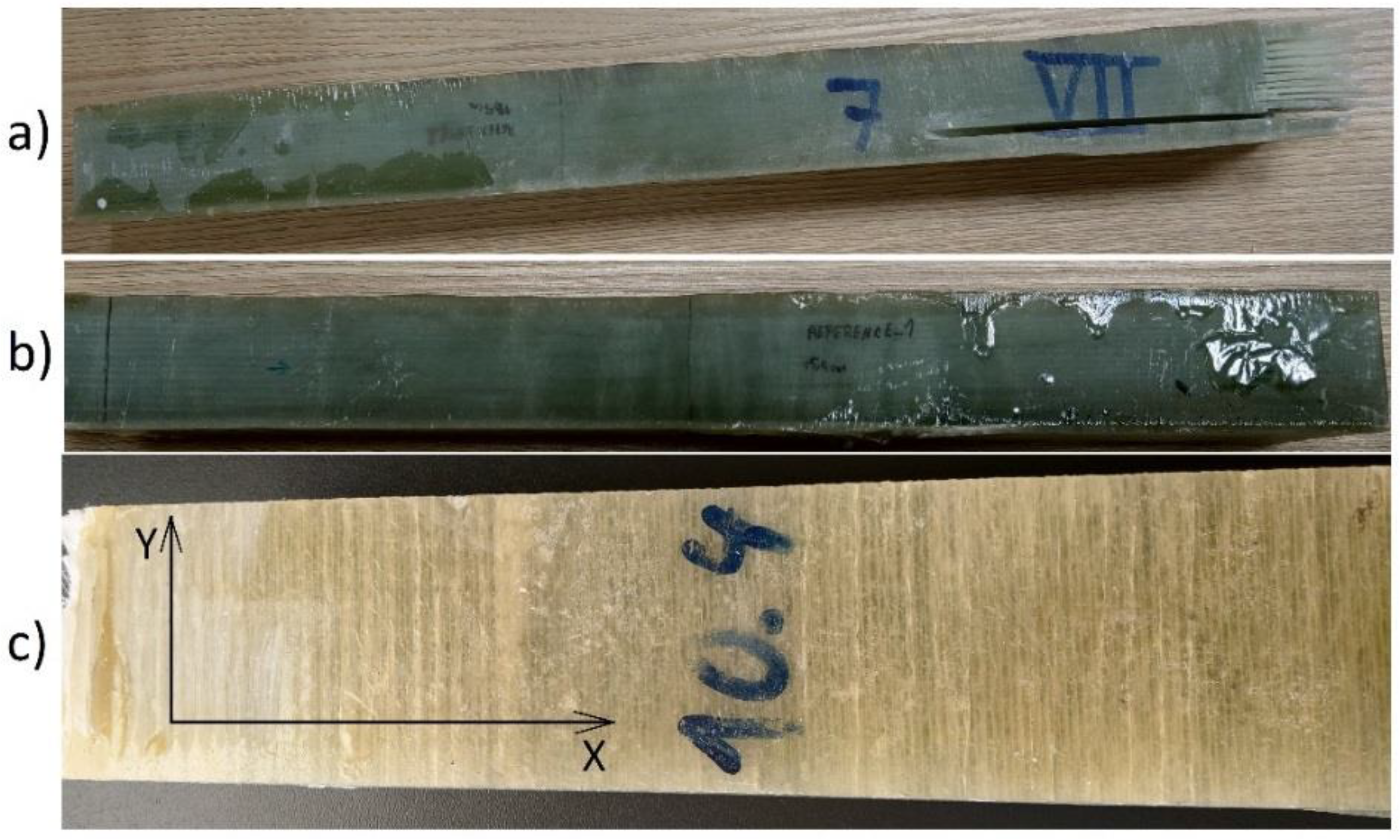
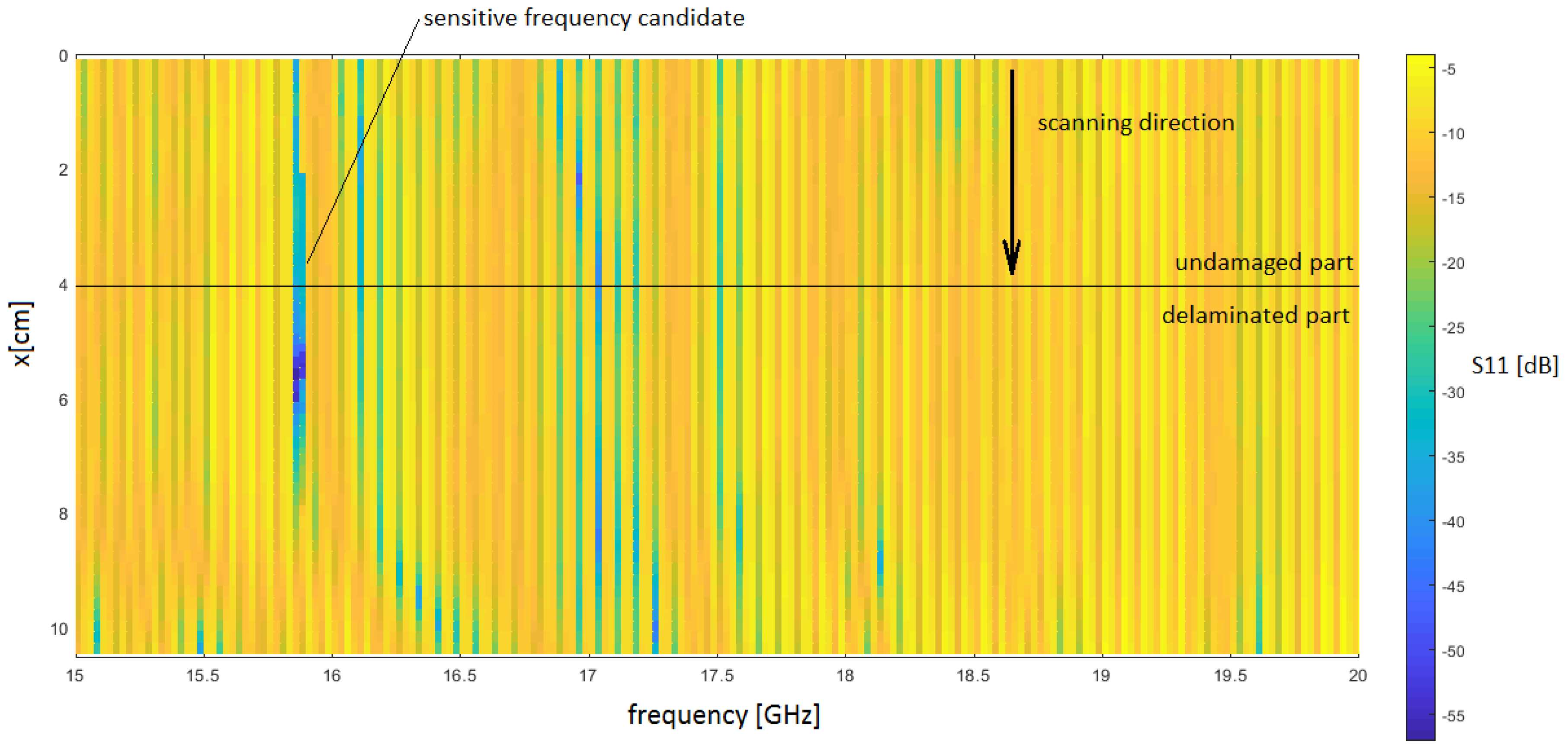


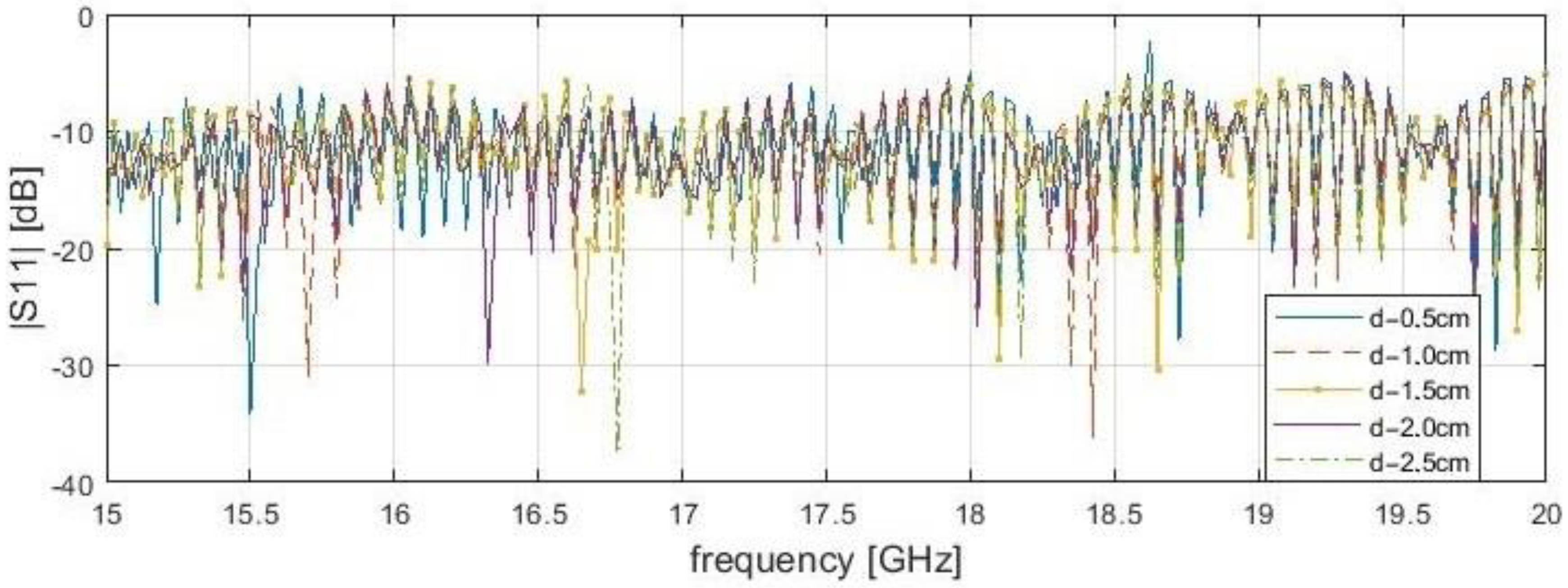
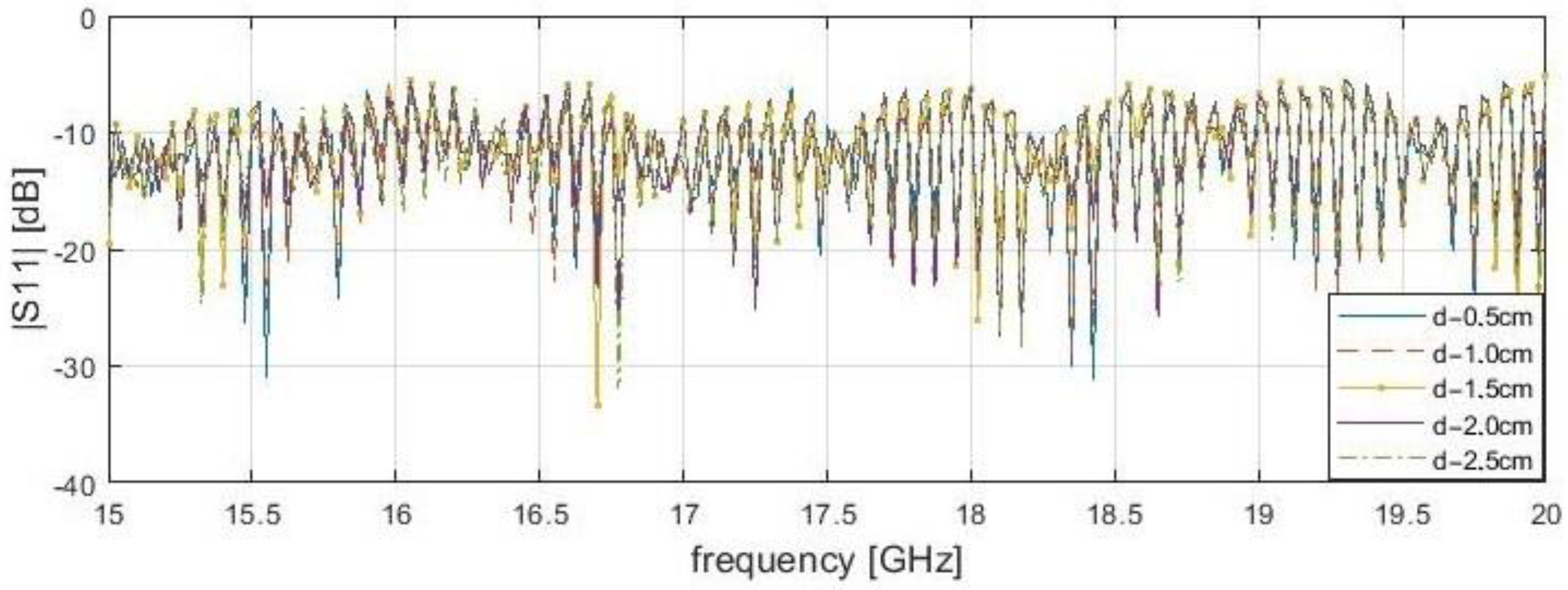
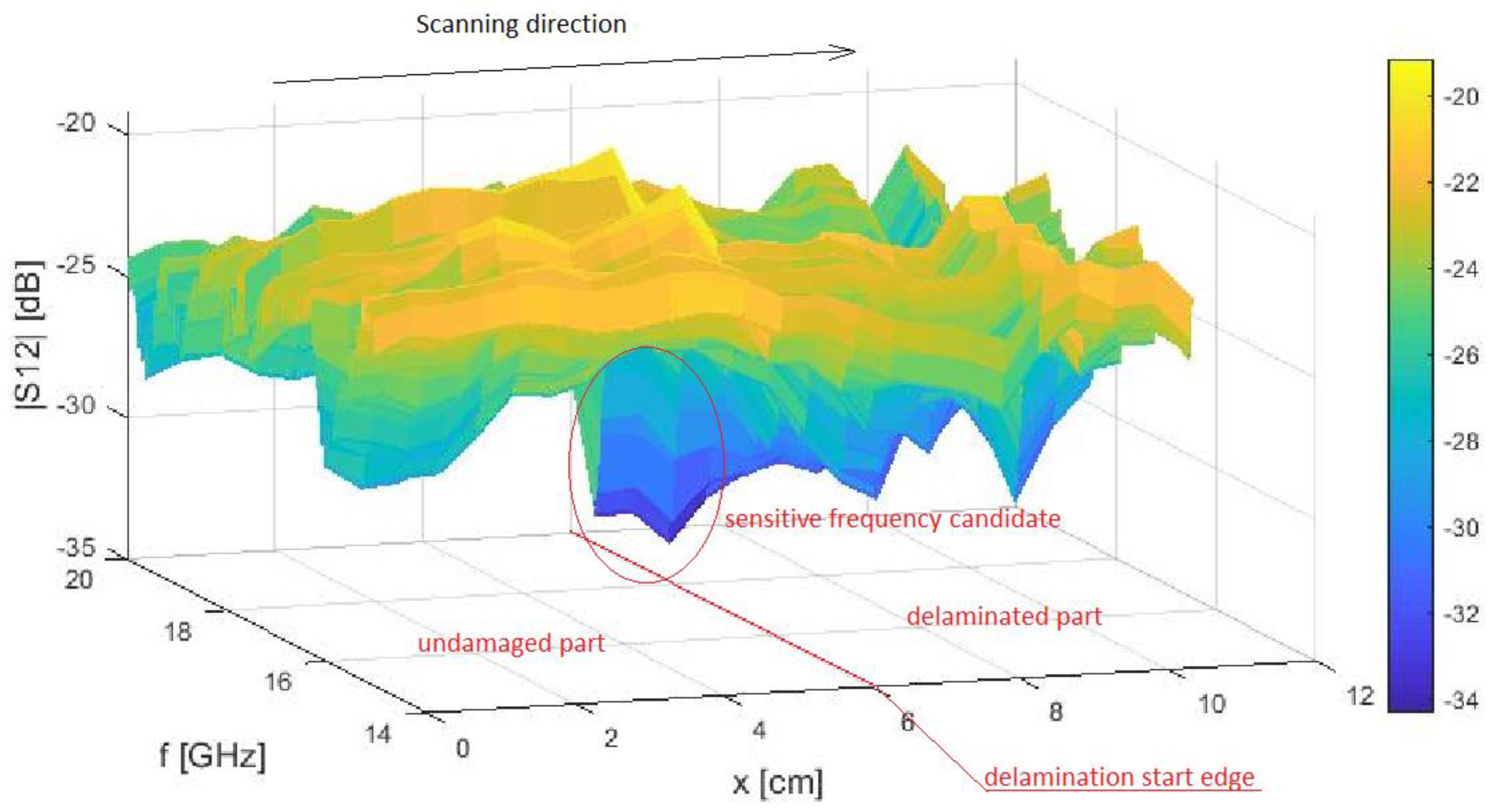

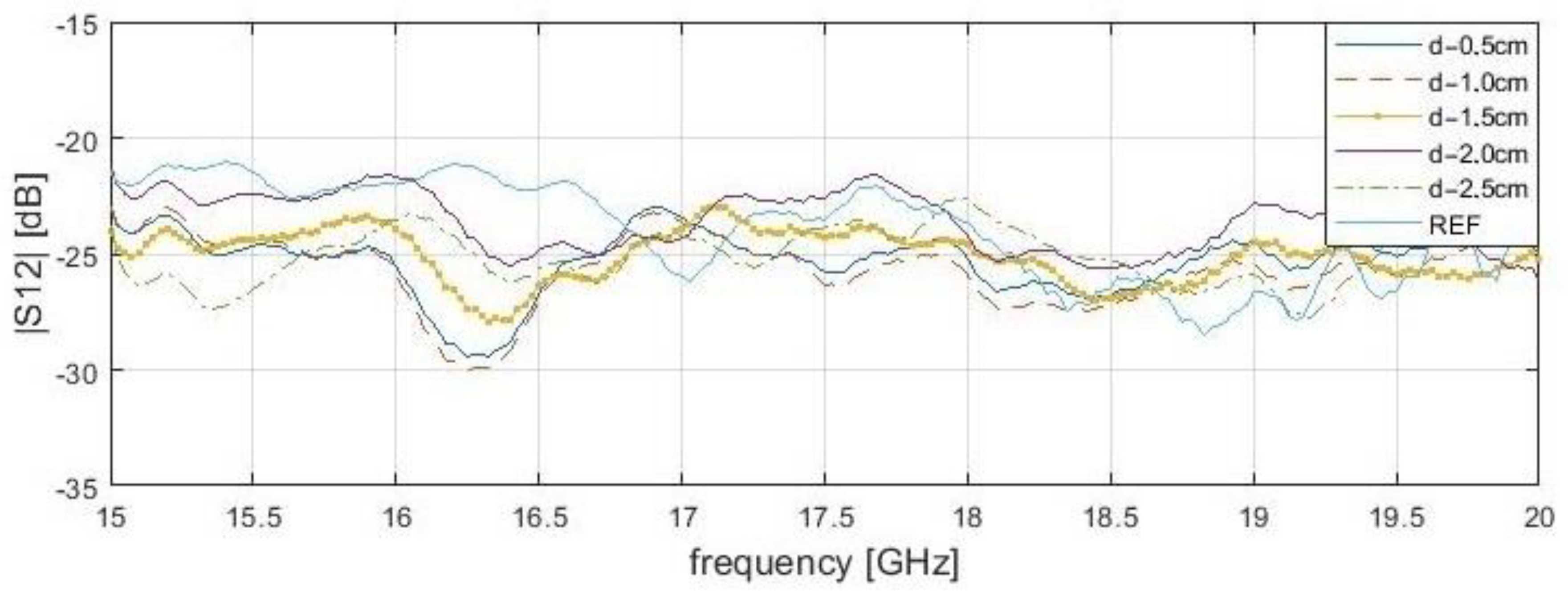
| Sample Number | Incision Depth (d) [cm] | Sample Number | Incision Depth (d) [cm] |
|---|---|---|---|
| 1–5 | 2.5 | 16–20 | 1.0 |
| 6–10 | 2.0 | 21–25 | 0.5 |
| 11–15 | 1.5 | 26–30 | Reference-no incision |
| Parameter | Value |
|---|---|
| Sample size | width: 60 mm, height: 40–45 mm, length: 350–500 mm |
| Effective scan area | 20 mm × 120 mm on every sample surface |
| Probe dimensions | aperture: width: 10.7 mm, height: 4.3 mm with a flange 23 × 23 mm (show in Figure 2b) |
| Δx, Δy | 2 mm, 2 mm |
| Frequency band | 15 GHz–20 GHz |
| Number of linear frequency points | 401 |
| Stand-off distance | 0.1 cm and 2.0 cm |
| Incision Depth | Without Conducting Plate | |||||
|---|---|---|---|---|---|---|
| Reflection Method Stand-Off = 0.1 cm | Reflection Method Stand-Off = 2.0 cm | |||||
| f1 [GHz] | |S11|min [dB] | Threshold 3σ [dB] | f2 [GHz] | |S11|min [dB] | Threshold 3σ [dB] | |
| Average reference level (μ) | - | −17.0 | −30.2 | - | −13.7 | −21.7 |
| d = 0.5 cm | 15.65 | −48.2 | 15.50 | −32.2 | ||
| d = 1.0 cm | 15.85 | −46.0 | 15.70 | −29.2 | ||
| d = 1.5 cm | 16.10 | −38.7 | 15.40 | −25.2 | ||
| d = 2.0 cm | 16.22 | −36.2 | 16.30 | −27.9 | ||
| d = 2.5 cm | 16.80 | −34.5 | 16.60 | −30.1 | ||
| Incision depth | With conducting plate | |||||
| Reflection method standoff = 0.1 cm | Reflection method standoff 2.0 cm | |||||
| Average reference level (μ) | - | −14.1 | −20.3 | - | −12.9 | −20.7 |
| d = 0.5 cm | 15.78 | −34.2 | 15.55 | −31.9 | ||
| d = 1.0 cm | 15.90 | −34.1 | 15.70 | −29.2 | ||
| d = 1.5 cm | 16.00 | −31.7 | 16.70 | −32.3 | ||
| d = 2.0 cm | 16.10 | −31.0 | 16.00 | −29.8 | ||
| d = 2.5 cm | 16.40 | −28.4 | 16.77 | −30.4 | ||
| Incision Depth | Transmission Method Stand-Off = 0.1 cm | Transmission Method Stand-Off = 2.0 cm | ||||
|---|---|---|---|---|---|---|
| f1 [GHz] | |S12|min [dB] | Threshold 3σ [dB] | f2 [GHz] | |S12| min [dB] | Threshold 3σ [dB] | |
| Average reference Level (μ) | - | −20.7 | −25.5 | - | −24.2 | −30.1 |
| d = 0.5 cm | 18.98 | −31.8 | 16.35 | −33.0 | ||
| d = 1.0 cm | 18.79 | −28.9 | 16.25 | −32.9 | ||
| d = 1.5 cm | 18.70 | −31.4 | 16.31 | −31.0 | ||
| d = 2.0 cm | 18.68 | −27.5 | 16.45 | −30.7 | ||
| d = 2.5 cm | 18.78 | −29.2 | 16.40 | −32.0 | ||
Publisher’s Note: MDPI stays neutral with regard to jurisdictional claims in published maps and institutional affiliations. |
© 2021 by the authors. Licensee MDPI, Basel, Switzerland. This article is an open access article distributed under the terms and conditions of the Creative Commons Attribution (CC BY) license (https://creativecommons.org/licenses/by/4.0/).
Share and Cite
Sobkiewicz, P.; Bieńkowski, P.; Błażejewski, W. Microwave Non-Destructive Testing for Delamination Detection in Layered Composite Pipelines. Sensors 2021, 21, 4168. https://doi.org/10.3390/s21124168
Sobkiewicz P, Bieńkowski P, Błażejewski W. Microwave Non-Destructive Testing for Delamination Detection in Layered Composite Pipelines. Sensors. 2021; 21(12):4168. https://doi.org/10.3390/s21124168
Chicago/Turabian StyleSobkiewicz, Przemysław, Paweł Bieńkowski, and Wojciech Błażejewski. 2021. "Microwave Non-Destructive Testing for Delamination Detection in Layered Composite Pipelines" Sensors 21, no. 12: 4168. https://doi.org/10.3390/s21124168
APA StyleSobkiewicz, P., Bieńkowski, P., & Błażejewski, W. (2021). Microwave Non-Destructive Testing for Delamination Detection in Layered Composite Pipelines. Sensors, 21(12), 4168. https://doi.org/10.3390/s21124168






